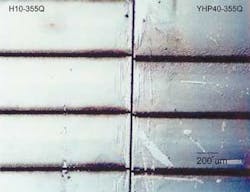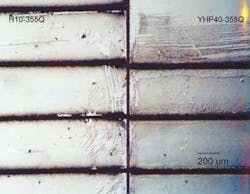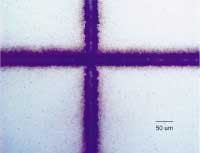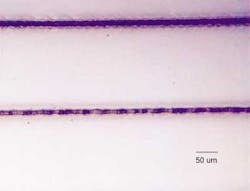Choosing UV for micromachining silicon
Semiconductor micromachining at UV wavelengths represents one of the faster-growing markets for diode-pumped solid-state (DPSS) lasers, which are now being used for wafer dicing, scribing, direct via forming, and three-dimensional structuring. DPSS lasers are available with a wide range of output parameters and, in order to maximize throughput and minimize costs in each application, it is important to use a laser whose characteristics are optimized for the task. This requires understanding how various output parameters affect the processing of semiconductor materials. This article describes the results of experiments conducted in our applications laboratory for this specific purpose with silicon samples.
We used two lasers to study how Q-switched laser performance influenced process speed and cut quality: a short-pulse laser, the Spectra-Physics HIPPO laser with a nominal pulse duration of <12 ns at 30–50 kHz, and a long-pulse Spectra-Physics Navigator II laser with a pulse duration of <35 ns at 30 kHz. In other experiments, we also compared the performance of a mode-locked Vanguard Nd:YVO4 laser, which produces 4 W of average power at a repetition rate of 80 MHz and a pulsewidth of 10 ps. The performance of these lasers is summarized in the table.
In the studies, an expanded laser beam was passed through a galvanometer x,y scan head and focused on the samples with a 100mm telecentric lens. The final spot size was approximately 15 µm in diameter and the scan rate was 150 mm/s unless otherwise noted. The studies were all carried out on 1-in-sq pieces of silicon wafer with a thickness of 625 µm. The grooves were examined and measured using a high magnification optical microscope.
Pulse duration effects
To investigate the effects of pulse duration, we operated both lasers at 30 kHz with an average power on the samples of approximately 3 W and created grooves in both horizontal (X) and vertical (Y) directions (relative to the beam polarization). In every case the vertical grooves were slightly wider, indicating a modest polarization influence (see Figure 1).
null
The grooves were approximately 20 microns in width in all cases, and the most noticeable effects of pulse duration were on groove depth. Average groove depth was 14 µm with the short-pulse laser and 24 µm with the long-pulse laser. In addition, the short-pulse laser created grooves with a "U" cross-section whereas the long-pulse laser produced sharper "V"-shaped grooves. In terms of groove quality, the long-pulse laser created noticeably more recast debris in the grooves and rougher edges.
Further microscopic examination of the grooves from both top and side views revealed that the grooves scribed by the long-pulse laser seemed to be a little narrower than those by the short-pulse laser. This may indicate a better focus for the long-pulse laser during the experimental set-up, which in turn would provide more efficient material removal. This variation, along with the fact that the depth measurements were somewhat subjective when optically locating the bottom of grooves, adds slight uncertainties to the quantitative results.
Any variations in experiments and measurements would account for only a small part of the large observed depth difference from the two lasers. It is therefore safe to conclude that the longer pulse duration is the main reason that we observed deeper grooves and increased material removal by the long-pulse laser.
null
null
To summarize, the long-pulse laser removed up to 70 percent more material at the same overall power, but the short-pulse laser produced better quality grooves with smoother edges.
null
A likely possible explanation for these observations is the ratio of "cold" and "thermal" processes involved. A Q-switched UV laser can remove material by direct multiphoton ablation or atomization, which is a relatively cold process. It can also remove material by a thermal process, which removes material as molten debris. Many applications involve a combination of these processes.
We believe that the observed differences are due to the distinct characteristics of these two processes. With the shorter pulses, the high peak power favors ablation, whereas the longer pulses with lower peak power would tend to favor a thermal process. It takes less energy to remove material by melting it than to vaporize it by breaking all the bonds holding it together. In addition, the high peak power due to shorter pulses may produce more plasma, which can partially shield the material from the laser beam.
Pulse repetition frequency effects
Keep in mind, however, that shorter-pulsed laser designs usually yield higher average UV power. This is because harmonic conversion efficiency is proportional to (peak power) for 355 nm and (peak power) for 266 nm output. Moreover, pulsewidth increases as the laser pulse repetition frequency (PRF) is increased. Thus, with increasing PRFs, the peak ultraviolet power decreases with lower pulse energy and longer pulsewidth. This effect is more evident for longer-pulse lasers than for shorter-pulse lasers. Consequently, a shorter pulse laser can deliver its highest average UV power at a higher PRF than a comparable longer-pulse laser. This difference is even more noticeable in the HIPPO laser, which is designed specifically for short pulse duration and high PRF (and hence high average power).
To study the influence of PRF, we compared grooves cut by the short-pulse HIPPO laser operated at three different PRFs: 30, 40, and 50 kHz. This resulted in average power levels on the sample of 3.09, 4.66, and 4.81 watts, respectively.
null
At all three PRF values, the measured groove width was approximately 20 microns (see Figure 2). However, the groove depth increases dramatically with increased PRF. The average groove depth at 50 kHz was 26 µm versus the average depth of 14 µm produced at 30 kHz—an increase of 87 percent. Referring back to the table, it is interesting to note that although operation at 50 kHz produces 56 percent more average power than at 30 kHz, both the peak power and pulse energy are lower at 50 kHz than at 30 kHz.
This indicates that increasing average power by raising PRF is an effective way of removing more material. This can be used to produce deeper grooves or the same depth at a faster scan rate.
Q-switched versus mode-locked
Mode-locked vanadate lasers are now viable alternatives to Q-switched lasers for some micromachining applications. We therefore decided to compare them to the Q-switched lasers for processing silicon. As indicated in the table, the particular laser we used is characterized by a high pulse rate (80 MHz), short pulsewidth (10 ps), and low pulse energy (40 nJ). But, it delivers the same average power on the sample as the two Q-switched lasers at 30 kHz (3 W).
Figure 3 shows grooves scribed by this mode-locked laser at different scan rates. At a scribe rate of 100 mm/s, the groove width was approximately 15 µm with a depth of 12 µm, less than that obtained with either of the Q-switched lasers, even though the scan rate is slower. In addition, there was almost no debris or re-cast material. However, there was a heat-affected zone (HAZ) clearly visible.
The narrower width is probably due to the fact that picosecond pulses remove material mainly by multiphoton absorption, which explains the almost total absence of debris. Multiphoton absorption has a non-linear dependence on the peak power, which magnifies the laser interaction at the beam center, where the power density is highest, and minimizes any interaction at the beam edges. The HAZ is presumably due to the high repetition rate of the laser acting as a pseudo-CW heat source.
These results are consistent with our previously reported data (see Industrial Laser Solutions, Dec, 2002) comparing Q-switched and mode-locked lasers in other materials. In that study, we found that a mode-locked laser is more efficient at micromachining polymeric materials, but Q-switched pulses are superior for materials with higher ablation thresholds, such as copper. Silicon has a higher ablation threshold, and again we conclude that the observed differences are due to pulse energy effects.
Conclusion
To summarize, if a silicon micromachining application requires high throughput and superior groove quality (smooth grooves with minimal debris), then the best ultraviolet laser is a Q-switched model that combines high average power with high peak power, that is, short pulses. If the sole important metric is process throughput, then the situation is a little more complex. The best laser would be a longer-pulsed Q-switched laser, providing it offers a similar average power level to available shorter-pulsed models. However, because a shorter-pulsed UV laser generally provides higher average power at a higher PRF, the final choice may involve subtle trade-offs. As our study shows, there are many factors that can come into play, and the only way to assess the performance of a given laser/material interaction is to fully test it in advance on real samples in an applications lab.
Mingwei Li, Spectra-Physics Inc., Mountain View, CA, can be contacted by e-mail at [email protected] or www.spectra-physics.com.






